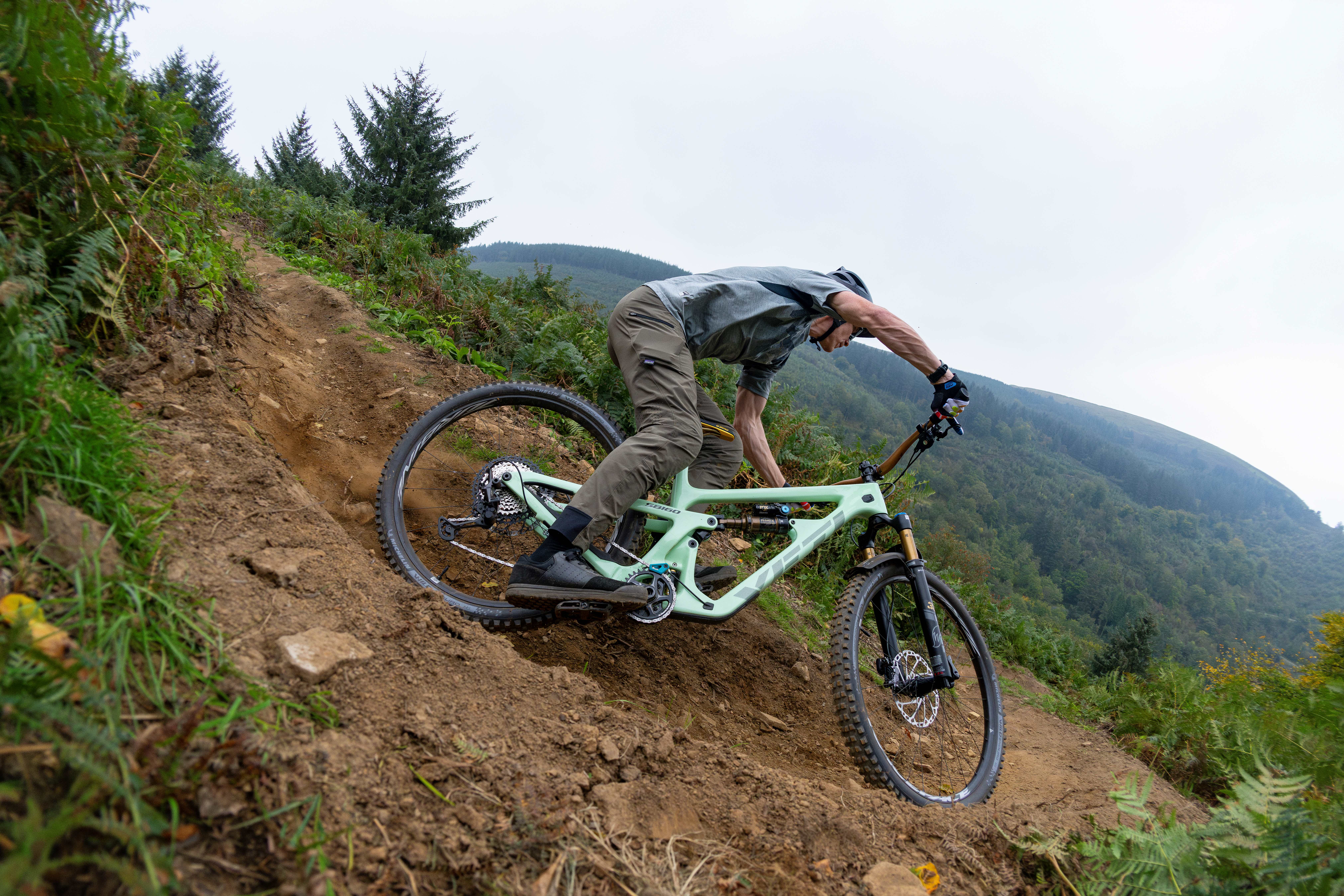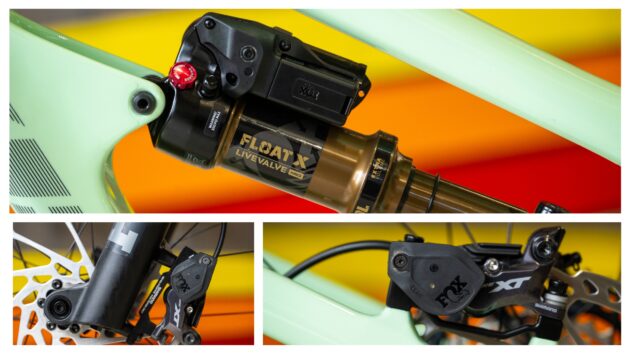Super fast and now wireless, Fox's reactive suspension tech – Live Valve – is back for a second go. Is it any better than the first attempt?
Fox carves out free speed on the descents with its new Live Valve Neo active suspension system

Jamie tests the latest Fox Live Valve suspension on the fruity trails at Risca, South Wales
Fox has a new suspension system out called Live Valve Neo that will open and close your shock faster than the blink of an eye and make your bike quicker and more efficient on the climbs… and the descents too.
That’s the big claim anyway, although it’s one we’ve heard before from Fox, which launched the original Live Valve back in 2018 to less than rapturous applause – we criticised it when we tested it. It’s now completely wireless, mounts its sensors on the brake calliper mounts, and gets tons more tuning options to mess around with too. And perhaps crucially it gets improved oil flow through its shock… sounds better already.
You can think of Live Valve Neo much like an automatic lockout lever for your shock then, one that’ll instantly open and close the damping circuits. It’s impressive technology, boasts amazing speed, looks brilliantly packaged and one we’re bound to see on some of the best mountain bikes in 2025. It’s also just the sort of technology we’ve been discussing in the latest MBR Show, where we ask: is mountain biking getting too easy? Check out the video…
Fox Live Valve Neo need to know
- New version of Fox Live Valve, automatically adjusts compression damping to optimise both pedalling and descending
- Bolt on sensors on the front and rear brake callipers feed data to the shock and brain and pass through its algo, which decides whether the shock is Active or Supportive (open or closed)
- Natural successor to Live Valve 1 back in 2018, now with no wires and proprietary wireless technology first seen on Fox Transfer Neo dropper post
- Fastest active suspension out there – data from sensors every 2.5 milliseconds, takes 14 milliseconds for the damping circuit to open or close
- Fully customisable settings – Standard, Firm, Plush, Open, and Closed – accessed through Fox app
- Available aftermarket, sensors are £450, then add a Float X shock for £1,119 or DHX for £1,099

There are no more unsightly cables to Live Valve now, instead it uses Fox’s own propriatary wireless system
What is the Fox Live Valve Neo?
We can’t go any further without mentioning the elephant in the room, SRAM’s brilliant Flight Attendant, which is really the benchmark for automatic suspension. Both Live Valve Neo and Flight Attendant have the same goal in mind, which is to give you firm, efficient suspension where possible, and open plushness where it’s not. They go about it in very different ways though.
Neo works with just three components on your bike: two sensors mounted to the brake callipers, and a control unit or brain integrated into the dedicated Neo shock. There’s nothing in the fork so Neo won’t lock that out as Flight Attendant does, and there’s no spindle attachment either to detect how fast you’re pedalling.

Rear sensor is discreet enough to be confused with a new pad temperature sensor, perhaps?
How does it all work?
There’s no more wires for starters, which was one of the main bugbears of the old Live Valve for many people – it just looked like such a mess. This time Fox has developed its own wireless protocol to send data from the sensors to the shock. Suddenly Fox’s boasts about the Transfer Neo dropper post speed make sense.

The fork sensor reacts to the trail, passes data to the Live Valve brain, which tells the shock how to respond
Those calliper-mounted sensors are pretty small and discreet, and what’s more they’re ideally placed for gauging the terrain and telling the shock what to do. That’s because they’re part of the unsprung mass of the bike and can tell the brain exactly how the wheels are reacting to the ground, rather than its effects on the bike itself.
The sensors use inclinometers and accelerometers to tell the shock whether to remain closed (the default position), or open up and absorb some trail chunder. Fox calls the two states Active and support, with Active fully open and Support not fully locked out but more akin to a pedal platform.
There’s no motor inside the shock to open and close the damping circuit, instead Fox uses a solenoid valve to open and close the aperture and cut off the oilflow to close it up. It’s a great design because it’s not power hungry or noisy like a motor.

On steep corners the compressed shock will cause the shock to unlock
What does that mean on the trail?
It’s really simple, hit a rock, root or bump on the trail with your fork and the shock will open up before the rear wheel even gets there. The fork internals don’t have any Live Valve gubbins inside because Fox says there’s very little efficiency from pedalling to be gained here, and it makes the application simpler too.
Once the shock’s open it will stay that way for a pre-set period of time, before closing up again. That sounds really simple, but it’s how long the shock circuits stay open for, and the force threshold required to open them up that really matters.
This is the secret source then, the inclinometers tell Live Valve Neo if you’re in one of three states – climbing, descending or on the flat – and the shock acts accordingly. When you’re climbing or on a flat traverse it prioritises support over plushness, increasing the force threshold required to open the shock up. Point downhill and the system stays locked, but there’s less force required to open it up and it’ll stay that way for longer too.

How great does this Yeti SB165 look with Live Valve? Almost imperceptible
How fast is Live Valve Neo?
Really fast is the short answer, but curiously enough much slower than the original wired Live Valve. The numbers are impressive if largely useless unless you’re an electrical engineer, but here’s the gist of it. Live Valve Neo will read the terrain every 2.5 milliseconds (400 times a second), signals from the sensor take around one millisecond to reach the controller, and it takes 14 milliseconds (1/70th of a second) for the damping circuit to open or close. That’s faster than any other auto lockout system around, Fox says, without naming Flight Attendant.
Back in 2018 Fox told us Live Valve 1 took just three milliseconds to open or close its solenoid valve though, with the bump sensors reading the terrain more than twice as often, at 1,000 times a second. Fox says it had to invent a new protocol to introduce Live Valve Neo and remove the wires. Does this mean Live Valve Neo is too slow? Categorically not, but perhaps it reveals there’s more to an automatic lockout than speed alone.

The two sensors use button batteries that last upwards of a year, while the shock uses a lithium ion battery that also fits into the Neo dropper post
Live Valve Neo customisation
One of the most important changes to Neo is that you can customise almost everything about the system from the Fox Bike App. The original Live Valve had to the tweaked in a bike shop, which made it much less user friendly. Today though you can get help with setup, get firmware updates, book in a service and most importantly tune the system to your riding.
There are five preset tunes — Standard, Firm, Plush, Open, and Closed — and each is fully customisable. This means you can change the bump sensitivity required to open the shock, and how long it stays open for. You can also adjust the angle required to initiate the climb, flat or descent protocol. And most importantly of all, it’s possible to use something called Precision Mode and put Live Valve Neo into open mode when descending.

Service tracking and system setup are open to customisation through the Fox app
How to set up Live Valve Neo
Initially Live Valve Neo will come on just a few as yet unnamed bikes, and almost certainly right at the top of the range. You can buy it as an aftermarket kit though, bolt it onto your bike, connect to the Fox app and calibrate the inclinometers. After that it’s a case of setting up the bike as usual, dialling in your sag, compression damping and rebound.
Live Valve Neo also has an additional dial on the shock body to select just how much support you want in the Supportive mode with the shock locked out. There are seven positions and they’re independent of the open compression settings of the shock

There are seven clicks of adjustment on the Live Valve shock, I started on fully supportive but ended up closer to fully open
How much does it cost?
A lot. You’ll need to fork out for a Live Valve Neo Kit, which includes fork and rear bump sensors, one battery, charger, and charger cable for £449.99, including VAT ($399 USD / $534.65 CAD / €499).
Then you’ll need to choose between a coil or air shock: Live Valve Neo Float X is £1,119 with VAT, ($999USD / $1399 CAD €1,299). Live Valve Neo Float DHX costs £1,099 with VAT ($949 / $1,269 CAD / €1,249).
A spare battery is $79 USD / $106 CAD / £99.95 / €99 and a spare charger and cable is $49 USD / $69 CAD / £62.95 / €79.

Climbing is recognisably easier with Live Valve Neo, this trail was steep enough to take pressure off the fork and let the shock lock out
How Live Valve Neo rides
I’m not a fan of the usual pedal platform switches to lock out the shock on climbs, simply because I invariably forget to flick them off again for the descents. Naturally that’s not a problem here, Live Valve Neo converted my Yeti 165 test bike into a hardtail on the climbs, and an enduro rocket on the descents, all without having to take my hands off the bars.
That’s the short answer, but I get the feeling there’s an awful lot of fettling involved to get the perfect setup here, and my couple of hours testing it brought up more questions than satisfactory answers. From physical setup with the lockout dial to staring at my phone and customising the app, Live Valve Neo adds a lot of potential faff to just riding your bike.

Live Valve intuitively switches between open and closed on more techie climbs, giving you incredible power and precision
To begin I twiddled the Firm Mode Adjust dial to its firmest setting to give myself a benchmark and feel the effects, which were immediately obvious. Climbing on tarmac or smooth Live Valve Neo is taut as an XC bike, but one with pretty wide tyres – efficient but comfy.
On lumpier fire roads I started to feel the shock open more often as the fork hit small dice-sized rocks and this helped me keep traction and rolling speed. It was almost too large a gulf between being active and supportive though, on a couple of occasions I spun the rear wheel after the shock firmed up suddenly, firing a rock unexpectedly out behind and probably losing me a few watts of power.
The solution was to dial off some of the support, which presumably lets more oil flow through the damping circuits. Just how many clicks to use would take plenty of working out though, and is bound to change between trails. But the most important take home is that there’s a big difference between the clicks and therefore plenty of adjustment on offer. On really techie and steep climbs the shock remained open and gripping when I needed it to, rather than saying stubbornly locked out.

Fox says Live Valve is quick enough to dive into its travel in a small berm like this, and firm up enough to fire you out the other side
The biggest compliment I can pay to Live Valve Neo though is that it was almost unnoticeable on most descents. The shock felt active and plush when I expected it too, which is pretty much all the time at Risca in South Wales where I tested the bike, a hillside that’s both steep and rough.
I rode the original Live Valve at a Pivot launch back in 2019 and even in the open setting the shock felt slightly throttled. Not so now, the Float X shock felt reassuringly normal. It’s still possible to load the bike into the ground to find grip without feeling a wall of resistance too, and it was unphased by switchbacks – something I thought might upset the balance and close the shock up between turns. I did notice there seems to be more support from the shock than I’m used to, slamming into berms as hard as I could the bike seemed to fire me back up the hill faster than I was used to.
I can’t comment on how the bike feels when jumping as I don’t know Risca well enough to find any lips (I’m sure there are plenty there though!). What I do know is that Live Valve Neo thankfully stayed open on drops and didn’t firm up for the landing.
Verdict
Live Valve Neo will be a race weapon in the right hands. In the limited time I rode the system it reacted with speed and alacrity, making the Yeti 165 test mule feel taut and almost like a trail bike at times. It’s undeniably efficient and for any kind of riding against the clock I believe this system will, and probably already has, won crucial seconds. Fox has done a great job integrating Live Valve Neo onto its shocks too, the sensors are really discrete and it’s better looking than Flight Attendant too. Away from the tape and for regular riding it’s probably less useful though, yes I felt faster and more efficient but you’ll pay a hell of a price for that. There are plenty of riders who’ll resent the extra faff of battery charging, perfect setup, and the extra weight involved too. Do I really need Live Valve Neo? Definitely not, but it doesn’t stop me wanting it on my next e-bike though.
















